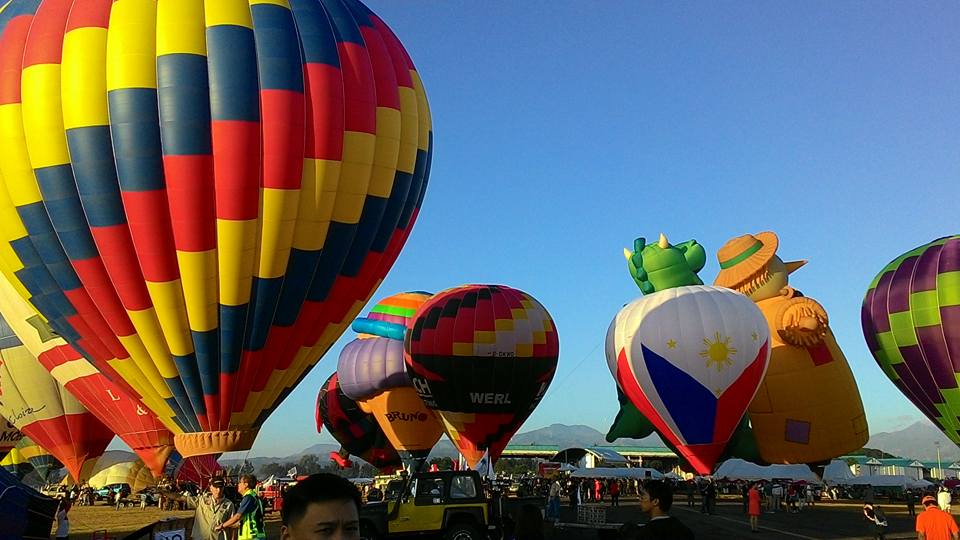
The Philippine International Hot Air Balloon Festival is a popular four-day event held annually in Clark Freeport Zone, Pampanga.
The event is widely acknowledged around the globe, attracting over a hundred balloon pilots every year. The long-running aviation sporting event features more than just hot air balloons, it’s a must-see event for anyone and it has a vibrant history.
What is The Philippine International Hot Air Balloon Festival
The festival, also known as “the weekend of everything that flies,” is popular not just for the colorful display of hot air balloons, but with the event comes the opportunity for you to see and experience flag jumps, microlight and rocketry demonstrations, skydiving, plane fly-bys and fly-ins, remote control plane and helicopter flying exhibitions, freestyle aerobatics, light airplane balloon bursting, flying formations, choreographed kite-flying, and pylon racing, to name a few. Clearly, there’s much to see and experience during the festival.
History
From humble beginnings to an international event (1994-1999)
The Philippine International Hot Air Balloon Festival can be traced back to 1994, a mere three years after the catastrophic eruption of Mt. Pinatubo. Then-tourism secretary Mina Gabor, with the support of Sang-kee Paik, British Airways General Manager John Emery, and German aviation enthusiast Max Motschmann, started the first-ever Philippine International Hot Air Ballon Fiesta to help the local economy in Central Luzon recover from the devastation caused by Mt. Pinatubo.
The fiesta’s primary aim was to establish hot air ballooning as an aviation sport in the Philippines and to make the region the premiere sports aviation and travel destination in the entire Asia-Pacific.
Inviting the Hot Air Baloon Club, the Clark Development Corporation and British Airways organized the first event. It welcomed 21 balloon pilots from 10 countries as its participants, with just one entry from the Philippines. The country was represented by the only registered balloon pilot at the time, Capt. Joy Roa.
From its successful inception in 1994, the 1995 iteration of the festival saw the participants grow to 27 balloons and a second entry from the Philippines. In the same year, ultra light planes have also been introduced to the event.
Facing the Challenges (1999-2000)
The Hot Air Balloon Festival remained successful up to 1999 when the event and its organizers had to grapple with financial difficulties. They had to cancel the event in 1999 due to budgetary constraints.
However, it didn’t take long for the Hot Air Balloon Festival to find its wing and experience a resurgence in the following year. In 2000, the event was revived in full force with twelve hot air balloons participating and 18 light planes coming together to join in the festivities. Pilots from Thailand, Singapore, and Japan flew in to the Philippines to showcase their talents. The participants in the year 2000 organized an air rally in support of the festival and to boost morale. Since then, it has become a regular attraction in the festival, and it’s ongoing to this day.
Evolution (2003-2016)
2003 introduced a revolutionary change in the traditional event format. Participants became more creative in their entries. For one, the event began to see specially designed and fabricated balloons, like South Korea’s newspaper-shaped balloon and Japan’s dog-shaped one. These loomed bright over Pampanga and became instant attractions. It also caught the attention of local and international brands, from telecommunications to apparel, as they sent in their fancy hot-air balloons.
There were even more participants from around the globe in succeeding years, drawing pilots and teams from countries like Germany, the UK, Sweden, the Netherlands, and Malaysia. This cemented the festival’s status as an international event.
Ways forward (2004-2019)
The Philippine International Hot Air Balloon Festival continues to flourish each year. In 2006, it gathered around 30 multi-colored hot air balloons and over a hundred balloon pilots from even more countries. The stunning skyscapes started to draw in record crowds, registering at least 60,000 visitors in 2006’s festivities.
Since then, it has grown to include other aerial sporting events, such as skydiving and paragliding. In more recent years, the festival has earned entries from big-ticket names, such as the Twinz Aerobatic Paragliders and the British Red Devils. These teams have done awe-inspiring aerial performances and have made the festival a must-see for aerobatic enthusiasts.
Today, the Hot Air Balloon Festival has extended to the ground, featuring artists and performers from all over the world. There are stage performances where the likes of folk dancers, ceramic masters, and carpet makers get to showcase their cultures and crafts.
Where the Philippine Hot Air Balloon Festival is Currently
In 2020, the festival was moved to the San Lazaro Leisure Park in Carmona, Cavite, to accommodate a growing number of participants. However, the pandemic hit and the festival was on hiatus the succeeding year.
Pampanga’s Hot Air Balloon Festival finally made its comeback in 2022 with food and music festivities at the Clark Global City.
If there’s one thing the festival has proven, it’s that Filipinos can be extremely resilient and see opportunities even amid catastrophes. The first festival was created in the aftermath of the Mt. Pinatubo explosion, so there’s much hope and excitement around what the organizers can do after the wake of COVID-19.
Prepare for the return of the Philippine International Hot Air Balloon Festival with Camella
Let Camella be your partner as you await the festival’s return this year. Whether the next Hot Air Balloon Festival will be held in Pampanga or Bulacan, Camella in Pampanga and Camella in Bulacan will allow you to experience all the excitement that the festival has to offer in your everyday living.
The exquisitely designed homes of Camella will provide you with opportunities to enjoy the environment you’re in. More importantly, Camella developments are strategically located, so you’re at the forefront and ready for the next Philippine International Hot Air Balloon Festival once it returns.


